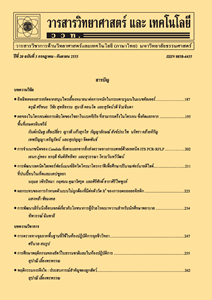การรวมเครื่องหมาย EST-SSR และ gSSR เข้ากับแผนที่เครื่องหมาย f-AFLP และเครื่องหมาย SuS ในอ้อย
Main Article Content
Abstract
บทคัดย่อ
งานวิจัยนี้ขยายแผนที่พันธุกรรมและเพิ่มความหนาแน่นของเครื่องหมายในแผนที่พันธุกรรมที่สร้างด้วยเครื่องหมาย f-AFLP เครื่องหมาย gSSR และเครื่องหมายจำเพาะต่อยีน sucrose synthase (SuS) ที่สร้างขึ้นก่อนหน้านี้ โดยการเติมเครื่องหมาย EST-SSRs จำนวน 212 คู่ไพรเมอร์ โดยใช้ประชากรลูกผสม F1จำนวน 283 สายพันธุ์ ที่ได้จากการผสมข้ามสปีชีส์ระหว่างอ้อยพันธุ์ปรับปรุง Phil6607 กับอ้อยสายพันธุ์ป่า Saccharum spontaneum พันธุ์ S6 เครื่องหมายทั้งหมดที่ใช้ในการวิเคราะห์แผนที่ประกอบด้วย เครื่องหมาย simplex และ double simplex จำนวน 1,511 และ 238 เครื่องหมาย ตามลำดับ ในการสร้างแผนที่พันธุกรรมกำหนดค่า LOD score ตั้งแต่ 4.0 ถึง 15 ค่า recombination fraction เท่ากับ 0.35 วิเคราะห์ลิงค์เกจได้ ทั้งหมด 232 ลิงค์เกจ มี 219 ลิงเกจที่สามารถนำไปวิเคราะห์กลุ่มโฮโมโลกัสลิงค์เกจได้ 11 กลุ่มโฮโมโลกัสลิงค์เกจ แผนที่ประกอบด้วยเครื่องหมายจำนวน 791 เครื่องหมาย แบ่งเป็นเครื่องหมาย EST-SSRs จำนวน 537 เครื่องหมาย เครื่องหมาย gSSR จำนวน 5 ,เครื่องหมาย, เครื่องหมาย f-AFLP จำนวน 246 เครื่องหมาย และเครื่องหมาย SuS จำนวน 3 เครื่องหมาย รวมความยาวกลุ่มลิงเกจทั้งหมดได้ 3,984 cM ความยาวของกลุ่มลิงค์เกจมีความยาวตั้งแต่ 0.4 cM ถึง 100 cM มีความหนาแน่นของเครื่องหมายเท่ากับ 7.13 cM แผนที่พันธุกรรมที่สร้างได้คาดว่าจะครอบคลุมประมาณ 52.1- 58.8 % ของทั้งจีโนม ในแผนที่พบเครื่องหมาย EST-SSRs ที่เกี่ยวข้องกับยีนที่สนใจศึกษา เป็นยีนที่เกี่ยวข้องกับกระบวนการเมตาบอลิซึมของน้ำตาล (Sugarcane metabolism) จำนวน 6 EST-SSRs, ยีนที่เกี่ยวข้องกับการต้านทานโรค (Disease response) จำนวน 7 EST-SSRs และยีนที่เกี่ยวข้องกับการทนต่อสภาพแวดล้อมที่ไม่เหมาะสม (Abiotic stress response) จำนวน 8 EST-SSRs แผนที่พันุกรรมที่สร้างได้จะมีประโยชน์อย่างมากในการเครื่องหมายกำกับหน้าที่ (functional markers) ที่สัมพันธ์กับ QTLs ของลักษณะที่สนใจซึ่งสามารถนำไปประยุกต์ใช้กับการปรับปรุงพันธุ์อ้อยโดยใช้เครื่องหมายโมเลกุล
คำสำคัญ : แผนที่พันธุกรรม; เครื่องหมาย EST-SSRs; เครื่องหมาย SSR; เครื่องหมาย f-AFLP; เครื่องหมาย SuS
Abstract
To extent the density of a previous sugarcane linkage map constructed from f-AFLP gSSRs and sucrose synthase (SuS) markers, 212 EST-SSRs were employed for integration of the markers using 283 F1 progenies derived from an interspecific cross between a cultivated sugarcane and the wild relative Saccharum spontaneum. With the markers already analyzed in the previous map, 1,511 and 238 markers of simplex and double simplex markers were constructed using a LOD score ≥ 4.0 and a recombination fraction of 0.35. The integrated genetic linkage map comprised 791 linked markers, including 537 EST-SSRs, 5 gSSRs, 246 f-AFLPs and 3 SuS markers that were assigned to 232 linkage groups forming 11 putative homologous linkage groups. All linkage groups represented a total map length of 3,984 cM, ranging from 0.4 cM to 100 cM with with a marker density of 7.13 cM. The expected proportion of a genome covered by the linkage map with 791 markers randomly placed was 52.1 - 58.8%. Based on high nucleotide homology searched 6, 7 and 8 EST-SSR showing putative functions of sucrose metabolism, disease response and abiotic stress response, respectively, were scattered in 5 homologous linkage groups. The integrated genetic linkage map of sugarcane constructed in this experiment can provide useful information to develop functional markers associated with QTLs of interest of which they can further applied in marker assisted breeding in sugarcane.
Keyword: Genetic linkage map; EST-SSRs; SSR; f-AFLP, SuS

